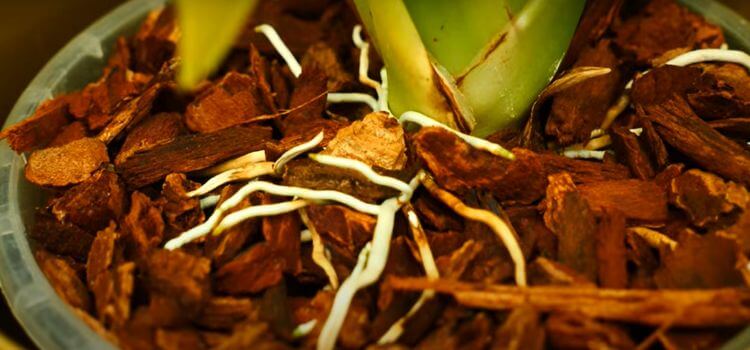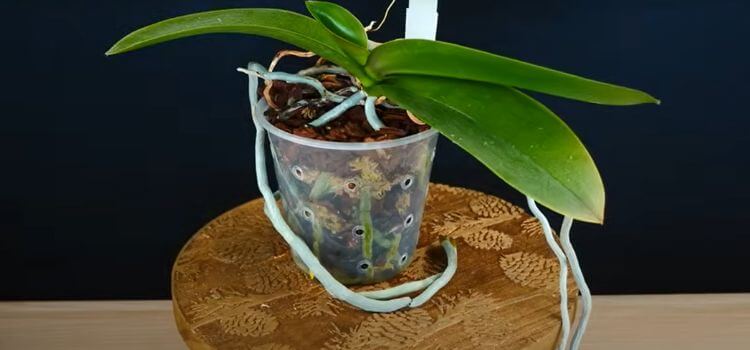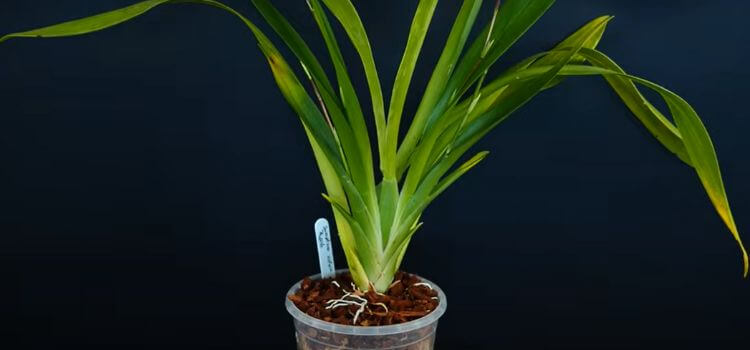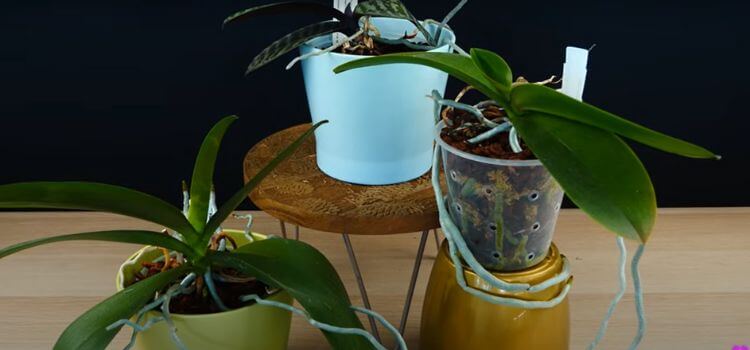As an Amazon Associate, I earn from qualifying purchases.
An orchid can survive with only air roots if it receives proper care and environmental conditions. Air roots absorb moisture and nutrients from the atmosphere.
Cultivating orchids has become a popular hobby, and they are appreciated for their unfamiliar beauty and diversity. These elegant plants belong to an extensive family, with air roots being a distinguishing feature for many species. Orchids with solely air roots often thrive in environments high in humidity, where they can harness the necessary sustenance directly from their surroundings.
This unique adaptation allows them to grow in unconventional locations, such as on tree branches or rocky terrains. Careful attention to moisture, light, and airflow is crucial to ensure that these plants not only survive but flourish with their aerial root systems.

Orchid Anatomy
Welcome to a fascinating exploration of Orchid Anatomy, a topic that intrigues gardeners and botanists alike. Orchids, with their dazzling flowers and unique structures, can survive in ways many plants cannot. They boast an incredible adaptation: air roots. These are not just mere offshoots; they’re lifelines that allow orchids to thrive in environments most plants would find inhospitable.
Root Structure
Orchids have a distinctive root system that sets them apart. Unlike most plants that have roots buried in the soil, many orchids develop roots that can freely hang in the air. These are called air roots or ‘velamen roots’. What makes these roots special? They’re encased in a porous layer of cells designed to absorb moisture directly from the air. They can also aid in photosynthesis, making them essential to the orchid’s survival.
- Thick protective layer to retain moisture
- Ability to absorb nutrients from the air and water
- Green tips indicating photosynthetic activity
Adaptations For Air Roots
Orchids have adapted beautifully to their environments. Their air roots exhibit several fascinating features to support their aerial way of life. An orchid can, in fact, live with only air roots, and here’s how:
| Adaptation | Function |
|---|---|
| Velamen | Absorbs water from humidity in the air |
| Spongy Tissue | Stores water for dryer periods |
| Chlorophyll | Conducts photosynthesis |
The root structures of orchids are prime examples of nature’s ingenuity. Each root is engineered to secure the plant, gather moisture, and even contribute to food production through photosynthesis. The illusion that these plants live on air alone is partly true; they do, and they do it remarkably well. With their adaptations, air roots help orchids survive where soil is scarce or nonexistent, such as on tree bark or rocks.
Orchid Care
Thriving orchids bring a slice of unfamiliar beauty into any home. Yet, mastering orchid care is crucial for these elegant plants to flourish, especially when dealing with only air roots. Orchid enthusiasts need to understand the essentials of watering, humidity, light, and temperature to ensure these air-rooted beauties reach their full potential.
Watering And Humidity
Air roots on orchids crave moisture from the environment. Understanding their unique watering needs is vital.
- Mist air roots regularly to maintain the right moisture level.
- Use room temperature water, avoiding tap water with high levels of minerals.
- Place a humidity tray nearby to boost moisture in the air.
Orchids do not like ‘wet feet.’ Ensure pots have adequate drainage to avoid root rot in potted specimens.
Light And Temperature Requirements
Proper light and temperature are critical in nurturing air-root orchids. These factors influence their health and blooming patterns.
Light
Bright, indirect sunlight is best. Direct sun can harm the leaves and roots.
Temperature
Day temps between 75-85°F (24-29°C) and night temps above 60-65°F (15-18°C)
With their striking air roots, orchids can enhance any living space. Proper care will cater to their unique needs, and they’ll provide enchanting blooms year after year.

Benefits Of Air Roots
Orchid lover often marvels at their plants‘ unique ability to thrive with air roots protruding into the open air. These roots are not a sign of neglect but a natural adaptation that provides key advantages to the orchid.
Nutrient Absorption
In the wild, orchids attach themselves to trees, using their air roots to soak up moisture and nutrients from the atmosphere. These roots have a special covering called velamen, which acts like a sponge, absorbing water and nutrients that the rain washes over them.
- Efficient water intake: Air roots can quickly absorb rainwater and morning dew.
- Access to nutrients: Fertilizers and organic matter in the air provide nourishment.
- Adaptation: Air roots adjust to fluctuating environmental conditions to ensure survival.
Stability And Support
The thick, wiry air roots of an orchid not only absorb nutrients but also lend crucial physical support. They help anchor the plant securely to its host or growing medium, which is crucial for the orchid’s growth and overall health.
| Function | Description |
|---|---|
| Anchor | Roots grip onto surfaces, keeping the orchid stable. |
| Support | Provide a sturdy base for the plant body. |
| Balance | Help distribute the plant’s weight evenly. |
Challenges Of Air Roots
Orchids with only air roots encounter specific challenges. Air roots are a unique adaptation for orchids, enabling them to thrive in their natural habitat. However, they bring particular difficulties to the home environment.
Drying Out Risk
Unlike roots buried in soil, air roots are exposed to the air, making them prone to drying out. Proper humidity levels are crucial for their survival. An orchid’s air roots demand a delicate balance. They thrive in environments where moisture is ample but not excessive.
Using a humidity tray can mitigate this risk. Ensuring regular misting can also help maintain moisture. Nevertheless, overwatering can lead to root rot, a condition just as harmful as drought. Thus, it is of utmost importance to strike a perfect moisture balance.
Maintenance And Monitoring
Orchids with air roots require careful monitoring. Unlike roots under soil, air roots tell a clear story of the plant’s health. Their colour, texture, and rigidity offer visual clues about their well-being. Green and plump roots suggest good health, whereas greyish and flat ones indicate the need for more water.
- Monitor air roots closely
- Adjust watering based on their appearance
- Look for signs of rot or over-drying
Proper maintenance includes gentle handling to avoid damage. Care is necessary when moving or repotting the orchid since air roots are fragile. Damage to these roots can hamper the orchid’s ability to absorb moisture and nutrients from the air.
Propagation And Repotting
Enthusiasts often ponder if an orchid can thrive with just its air roots. Air roots are not just quirky twists of nature but vital to an orchid’s survival and even its multiplication. This section sheds light on the ingenious ways to use these aerial wonders for propagation and the critical aspects to consider during repotting.
Utilizing Air Roots For Propagation
Orchids are fascinating plants that defy the usual rules of growing. Their thick and silver air roots absorb moisture and nutrients from the air. Propagating orchids using these roots can be a rewarding endeavour—it’s almost like giving life to a new plant from thin air!
- Select a healthy air root about 15 cm long.
- Use a sterile blade to make a clean cut below a node.
- Place the cutting in a suitable growing medium.
- Maintain high humidity and warmth to encourage growth.
Repotting Considerations
When the time comes to repot an orchid, proceed with caution. Air roots are sensitive and vital to the orchid’s health. Here’s a straightforward guide to repotting with care:
| Step | Action | Tips |
|---|---|---|
| 1 | Choose the right pot | Ensure drainage and airflow |
| 2 | Prepare the medium | Opt for orchid-specific mixes |
| 3 | Remove the old pot | Be gentle to not damage roots |
| 4 | Place in new pot | Arrange air roots naturally |
| 5 | Secure the plant | Add medium around the base |

Frequently Asked Questions
To save an orchid with only air roots, provide high humidity, use a well-draining potting mix, water carefully, and ensure proper lighting. Support the plant with a stake if needed, and maintain a stable environment to encourage new growth.
Air roots are essential for orchids, providing vital functions like absorbing moisture and helping with photosynthesis. It’s important to let them grow undisturbed.
An orchid cannot survive without roots as they are essential for absorbing water and nutrients. Root regrowth is possible with proper care and the right conditions.
An orchid cannot grow from roots alone; it needs a stem and leaves to photosynthesize and sustain growth.
Conclusion
Orchid enthusiasts often wonder about air roots and plant survival. The answer is clear: orchids can indeed thrive with just air roots. Proper care, including adequate humidity and light, enables these resilient plants to absorb moisture and nutrients from the atmosphere.
Embrace orchids’ uniqueness and relish in their air-rooted resilience.

